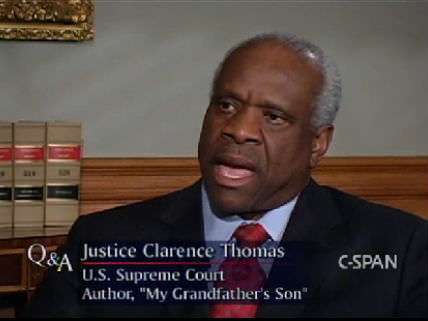Another Day, Another Bogus New York Times Attack on Clarence Thomas
The Gray Lady misleads its readers about the conservative Supreme Court justice.

Last week The New York Times published a story with the sensational headline "Clarence Thomas, a Supreme Court Justice of Few Words, Some Not His Own." Some not his own? Was the Times accusing Thomas of plagiarism? It sure seemed like it was. Here's how the piece began:
Justice Clarence Thomas has not asked a question from the Supreme Court bench since 2006. His majority opinions tend to be brisk, efficient and dutiful.
Now, studies using linguistic software have discovered another Thomas trait: Those opinions contain language from briefs submitted to the court at unusually high rates.
The piece goes on to describe Thomas' opinions as "rely[ing] heavily on the words of others" and employing "borrowed language." In fact, the Times spends a full 14 paragraphs painting Thomas as a sort of lone incompetent (or worse) unable or unwilling to write his own opinions without outside help.
But then we reach paragraph 15, which reads as follows:
Over the years, the average rate of nearly identical language between a party's brief and the majority opinion was 9.6 percent. Justice Thomas's rate was 11.3 percent. Justice Sonia Sotomayor's was 11 percent, and Justice Ruth Bader Ginsburg's 10.5 percent.
In other words, if you stick around long enough to read the fine print, you discover that the Times has been misleading you all along. Thomas has done nothing unusual. His writing conforms to standard practices among the justices.
Needless to say, this deceptive story has come in for some well-deserved criticism. The most trenchant of which came from George Washington University law professor Orin Kerr, a former clerk to Justice Anthony Kennedy, who had this to say about the Times' misdeeds:
The implication is that Justice Thomas is not doing his job. Not only does he not ask questions, he doesn't even think for himself.
For the New York Times audience, it's the kind of ideological catnip that is likely to make a lasting impression. No wonder it has been a main link on the Times homepage for most of the last day.
If you look at the data, though, they don't support the conclusion that Justice Thomas is an outlier….
Yes, Thomas has the highest shared language percentage. But it's bizarre to say that his numbers are "unusually high," that Thomas "relies heavily" on outside language or that "many" of his words are "not his own." All of the Justices share language from the briefs at roughly similar rates: about 7 to 11 words out of 100. And the difference between Thomas and Sotomayor is a rounding error. It's only 2.5 words out of 1,000. In a typical majority opinion, that's probably the difference between including a short parenthetical quote from a precedent and leaving it out.
Today, New York Times Public Editor Margaret Sullivan issued a response to the criticism leveled by Kerr and others. She did her best to defend the piece, but facts are facts, and Sullivan was ultimately forced to concede that "the overall impression it left may well have overstated the case." No kidding.
Unfortunately, this is not an isolated incident. The New York Times has a long history of publishing misleading negative items about Justice Thomas. For example, early in Thomas' tenure on the Court, the Times famously described Justice Antonin Scalia as Thomas' "apparent mentor," a cheap shot designed to portray Thomas as an intellectual lightweight. Yet as we now know, Thomas has been the one influencing Scalia—an influence that Scalia himself has repeatedly acknowledged. Yet the demonstrably false notion of Thomas as Scalia's "sidekick" continues to persist in many quarters of the American left.
I realize that Clarence Thomas' legal views are unpopular among many of the reporters and editors who work at The New York Times. But their bias against him is no excuse for this sort of specious journalism.


Show Comments (160)